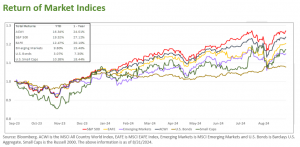August began with a pullback in the stock market, with the S&P 500 falling over 6% in the first three trading days and the “Magnificent Seven” stocks dropping nearly 10% in the first week. The selloff was fueled by concerns that the Federal Reserve had been too slow to cut interest rates. The labor market has softened considerably with July’s nonfarm payrolls significantly missing expectations and with June’s figures also revised downward. The unemployment rate in July ticked up to 4.3%, compared to the consensus of 4.1%, sparking discussions that the economy was headed for a hard landing.
Following the July labor report, expectations for a Fed rate cut soared, with the market pricing in a high probability of a 0.5% cut in September given hard landing concerns. The market reaction was further intensified by an unwinding of the yen carry trade, given the divergence between Fed and Bank of Japan policies, after the BoJ unexpectedly raised rates at a time when the US and most other central banks are lowering them.
As we discussed last month, we believe the rise in unemployment in July was likely due to a temporary increase in the labor force and weather-related layoffs. It was therefore unsurprising when the August jobs report, released last week, showed a decrease in the unemployment rate to 4.2%. Additionally, the job market showed signs of stabilizing, with the ratio of job openings to unemployed workers falling to a healthy 1.07, in-line with the pre-pandemic average since 2004.
Last month saw the Fed release the FOMC Minutes from the July meeting which shared insight into where the Fed is most focused. Members concluded that the risks to achieving the Committee’s employment and inflation goals were becoming more balanced, though the economic outlook remained uncertain. They noted that consumer spending had slowed from the strong pace of last year, reflecting restrictive monetary policy, easing labor market conditions, and slowing income growth. Some members also pointed out that lower-and-moderate-income households were facing increasing financial pressures, as seen in rising credit card delinquency rates and a growing number of households paying the minimum due on their balances.
The equity market rebounded and erased the early-month declines as soft landing odds rose over the course of the month and the Fed essentially confirmed it would cut in September as recession risks remain low. Powell said that the upside risks to inflation have diminished, downside risks have cooled, and the Fed was committed to doing everything it could to support a strong labor market.
Skipping Stones: What are the implications of a shift in Fed policy?
We don’t know for certain how the Fed’s actions will unfold, but in his speech at Jackson Hole, Federal Chair Powell made clear that “The time has come for policy to adjust. The direction of travel is clear, and the timing and pace of rate cuts will depend on incoming data, the evolving outlook, and the balance of risks.” We expect the initial result of a lower Fed Funds rate will be modest: a proportionate decline in the yield of money markets, savings accounts, and new Treasury Bills.
Secondary effects will likely take time to manifest. Banks will lower CD rates, and investors seeking yield may shift funds from cash and short term Treasury Bills to bonds with longer maturities which in turn puts downward pressure on yields farther along the curve. Mortgage rates and other loans, which tend to track changes in 5-Year Treasuries, have been falling, albeit slowly. The average rate on the 30-year mortgage is now at 6.7% which is below last year’s peak of 8.1%. Eventually, lower rates could provide a tailwind to consumers who face higher interest costs.
Like a stone thrown into still water, the magnitude of the secondary effects – the splash and the ripples – will be dependent on the size of each rate move and how quickly each subsequent move follows. We believe that a single 0.25% pebble or even a handful of pebbles thrown before the end of the year (such as three 0.25% cuts), would likely cause much less of a disruption than a chunky 0.75% boulder.
Capital Markets
Both equity and fixed income markets rose in August, except for U.S. Small Caps. The All-Country World Index (ACWI) rose +2.57%, the S&P 500 rose +2.43%, while the EAFE rose +3.27%. Small Caps gave back part of July’s 10% surge, falling -1.5% in August. Emerging markets finished with a gain of +1.64%. U.S. Bond prices rose +1.4% for the month.





